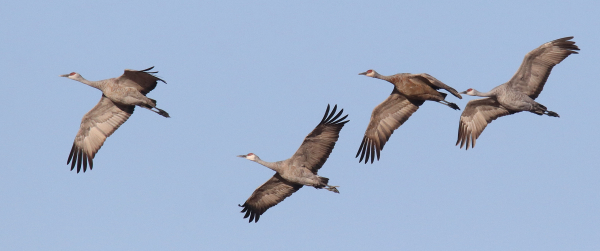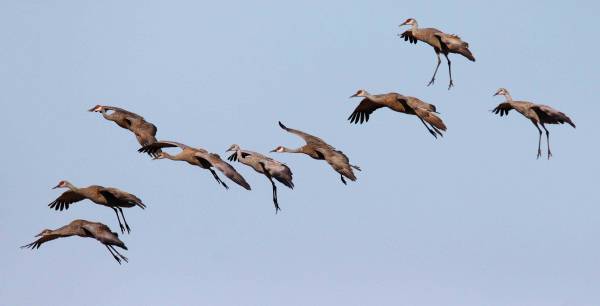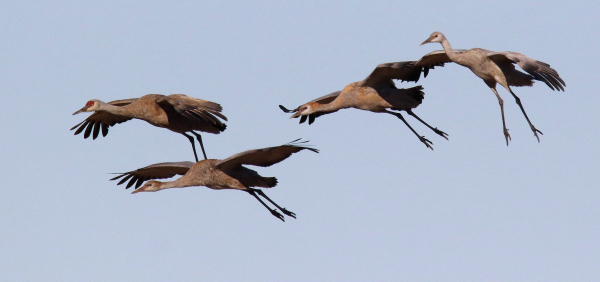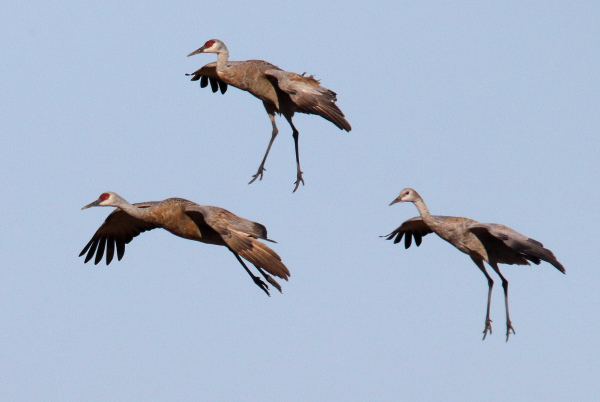To be surrounded by the sounds of Sandhill Cranes, loud and clear with long flocks of cranes crossing the clear October sky before me – how do you beat that for a birding experience, especially with a camera with a zoom lens in your hands – count me in! It was a bit of a replay of my Sandhill photo session 2 weeks earlier, but considering the scarcity of spring crane sightings in this region during spring, I wanted to make the most of what could be the peak of fall Sandhill Crane migration.

Indeed, with a front pushing an ever-stronger northwest wind into the area there were some flocks of Sandhills clearly migrating in a southerly direction high overhead, and while I took a few photos of a couple of those flocks as they passed nearby, now I was concentrated on low-flying flocks of gray cranes that were flying straight into the new volume of wind. As groups took flight from a nearby pond where they rested, drank water, and socialized through much of the afternoon, they formed flocks headed for another feeding period. With the sun at my back, I had positioned my mobile blind (vehicle) in just the right location to visually follow the approach of flocks rising up to my right and crossing the sky before me.

A flock of about 40 Sandhills was already spread across a portion of a harvested wheat field to my left, feeding on waste grain and any large insects on hand. This feeding flock gave the approaching wary cranes the green light to join the late afternoon feeding session. Each flock was followed by 3 or 4 others, so the action was almost constant. I tended to get the best flight photos when the cranes were positioned broadside, as they flew in a linear or tight V formation. As a flock passed, I switched my focus to the next incoming flock to begin refocusing on it, waiting for cranes to create spacing, watching for wing positioning, trying to anticipate their actions – and enjoying it all at the same time. This is what bird photography is all about: The anticipation, the excitement, the composition, the focus, the action, the follow-through – repeat, repeat, repeat.

After photographing some initial flocks as they passed, I noticed that as flocks were approaching their intended touchdown area, they began dropping their legs and cupping their wings – a typical move when cranes want to drop faster toward the ground. That led me to follow each flock a little longer to document this behavior, which can create quite attractive images in the process. The Sandhills drop their legs to help stabilize them and center their balance to bring them on a more direct gravity drop from on high. At the same time, the cranes cup their wings in a manner that produces a parachute-like form that results in a similar effect, dropping down, but in a controlled. slower way.

At the same time, with their wings cupped, the cranes can still maneuver smoothly while losing altitude quickly. Their posture while “parachuting” provides some interesting images, especially when more than one bird is involved. As it turned out, the parachuting behavior didn’t continue very long, probably because the increasing wind made the cranes fly lower as they approached the landing zone, but changes in birds’ behavior, and even their flight paths, are all part of these photo sessions.

There were 2 other opportunities to photograph Sandhill Cranes as I worked my way through Long Lake National Wildlife Refuge, one just north of the refuge and another south of the primary refuge lake. As I photographed the cranes, and especially when I was able to review photographs on my computer screen after returning home, it was quickly noticeable that there was a much higher percentage of first-fall Sandhills among the flocks. Now the young Sandhills seemed to be almost as abundant as adults in many flocks, but were probably more like 1/3 of all the cranes in the flocks I photographed; whereas few young of the year were present in the flocks I photographed 2 weeks earlier at the end of September.
I must admit that I kept the camera settings standard throughout the Sandhill photo sessions. I thought about increasing the area in focus by changing the aperture from my standard f-8 to at least an f-10, but I decided to emphasize the shutter speed instead, and for the most part it worked well, especially because the cranes were staying in mostly linear flights as they flew into the wind rather than spreading out in wide V-shaped flocks as can be the norm. Also, because I was positioned a considerable distance from the cranes, the ”average” aperture worked better than if I was closer to the flocks. I’m happy with the results provided by the f-8 aperture and 800 ISO setting that resulted with super-fast 1/4000 and 1/1600 shutter speeds, but in retrospect I could easily have increased the aperture to f-10.

As you probably have read before, cranes are a special family of birds for me, having studied cranes on 4 of the 5 continents cranes inhabit – Africa, Asia, Australia, and North America (I’ve seen cranes in Europe too, but only briefly). There is something very special about these large, tall birds with wild calls that are often limited to the wildest corners of their present day ranges. Some, like Whooping Cranes, Siberian Cranes, and White-naped Cranes are exceptionally rare, although thankfully, Sandhill Cranes are the most abundant species of cranes. With all that in mind, I certainly enjoyed every minute photographing the cranes, even while recalling opportunities of photographing far-away species – Blue Cranes, Gray Crowned Cranes, and Sarus Cranes among them.
With cranes and swans in the region now, geese should be arriving soon, creating a trifecta of large, flocking birds that can increase to flocks of hundreds and thousands with exceptional voices that add so much to the aura of birding during fall migration. We’re officially at the midway point in October now, perhaps at the midway point in fall migration, with plenty of exciting photography opportunities ahead. It’s time to do all you can to plan and create quality bird photography experiences; it’s still National Wildlife Refuge Week, so consider a visit to refuge near you for quality bird photography opportunities – they happen every day.
Article and Photographs by Paul Konrad
Share your bird photos and birding experiences at editorstbw2@gmail.com